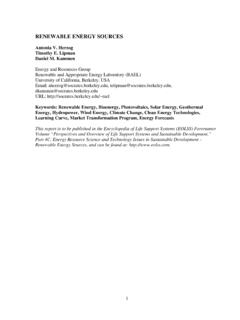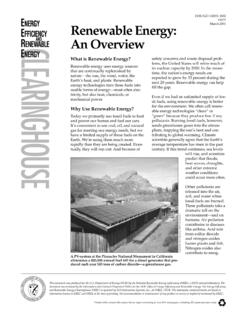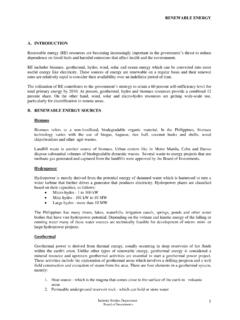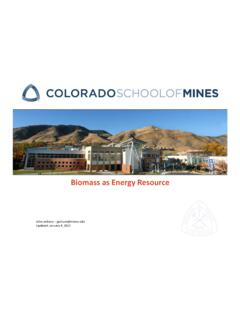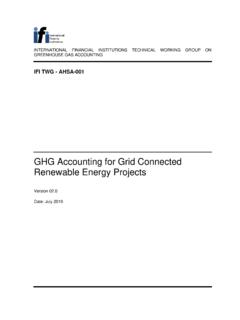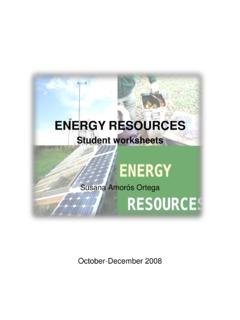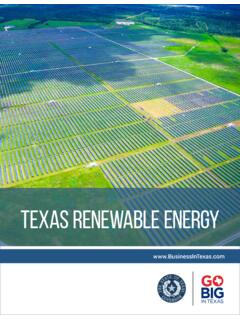Transcription of Biomass Basics: The Facts About Bioenergy
1 Biomass Basics: The Facts About Bioenergy1We Rely on EnergyEvery DayEnergy is essential in our daily lives. We use it to fuel our cars, grow our food, heat our homes, and run our businesses. Most of our energy comes from burning fossil fuels like petroleum, coal, and natural gas. These fuels provide the energy that we need today, but there are several reasons why we are developing sustainable of fossil fuels can be harmful to humans and the environmentWhen fossil fuels are burned, they release carbon dioxide and other gases into the atmosphere. Some of these gases pollute the air we breathe and contribute to climate change which threatens ecosystems and could lead to flooding, drought, or famine in some parts of the world. We are running out of fossil fuels Fossil fuels take millions of years to form within the Earth. Once we use up our reserves of fossil fuels, we will be out in the cold - literally - unless we find other fuel sources.
2 Bioenergy , or energy derived from Biomass , is a sustainable alternative to fossil fuels because it can be produced from renewable sources, such as plants and waste, that can be continuously fuels, such as petroleum, need to be imported from other countries Some fossil fuels are found in the United States but not enough to meet all of our energy needs. In 2014, 27% of the petroleum consumed in the United States was imported from other countries, leaving the nation s supply of oil vulnerable to global trends. When it is hard to buy enough oil, the price can increase significantly and reduce our supply of gasoline affecting our national security. Because energy is extremely important to our economy, it is better to produce energy in the United States so that it will always be available when we need it. 3We need new energy sources to replace fossil fuels A number of renewable resources like solar, wind, hydropower, geothermal, and Biomass have the potential to transform the energy supply for the better.
3 These energy sources are called renewable because they never run out. They can also be produced locally and do not have to be imported from other the United States, our economy is largely designed to run on fossil fuels for example, our cars run on gasoline made from oil, and most of our power plants use coal, natural gas, or other fossil fuels to produce electricity. Decreasing the carbon intensity of this existing infrastructure can be costly and slow-going. To help develop the new systems we need, the Government supports research and development (R&D) that private companies are unlikely to undertake on their of the Government s most important R&D focus areas is renewable transportation fuels. energy legislation has set long-term goals for developing these fuels. The Department of energy (DOE) is working with universities, national laboratories, non-profits and private companies to develop new fuels for cars, trucks, boats, and jets.
4 4 One of the most promising renewable energy sources for transportation is Biomass . Biomass is any organic material that has stored sunlight in the form of chemical energy , such as plants, agricultural crops or residues, municipal wastes, and algae. DOE is focusing on new and better ways to make liquid transportation fuels or biofuels, like ethanol, biodiesel, and renewable gasoline. DOE is also investigating the potential of producing power and a range of products from is the most widely used biofuel in the United States today, and is available at almost every gas station. Today, more than 95% of gasoline is E-10, a blend of 10 percent ethanol and 90 percent gasoline. At some stations, ethanol is also sold as alternative fuels known as E-15 and E-85. Although not yet widely available, E-15, containing 15% ethanol, improves upon the emission reductions of E-10 and can be used in cars newer than 2001.
5 E-85 contains 85 percent ethanol and is used in specially designed cars and trucks known as flexible fuel vehicles (FFVs). More than seventeen million FFVs are on the road today. Many people own FFVs and do not even know it. To determine if your vehicle is an FFV, check the inside of your car s fuel filler door for an identification sticker, consult your owner s manual, or visit and click on Flex-Fuel Vehicles. Biomass is an exciting, versatile energy source5 Gasoline34%reduction51%reduction88%reduc tion96%reductionCornSwitchgrassCorn StoverMiscanthusreductionSugar CaneEthanol is a domestically produced alternative fuel most commonly made from corn, sugar cane, switchgrass, and crop residues such as corn stover. Ethanol production results dramatically fewer greenhouse gas emissions than conventional fuels. This is partly due to their ability to be grown locally eliminating a need to transport crude from other countries.
6 The production method of ethanol depends on the type of feedstock used, and recent innovative technologies have helped to make the production more energy efficient. Biofuel production will become even cleaner and cheaperBiofuels Reduce Greenhouse Gas Emissions Reductions Vary by Feedstock and Type of energy Used for Processing6 Growing & Harvesting Feedstocks energy crops Crop and forest residues Municipal wasteConverting Feedstocksto Fuel at IntegratedBiorefineriesProcesses: Biochemical conversion technologies involve pathways that use sugars and lignin intermediates. Thermochemical conversion technologies involve pathways that use bio-oil and gaseous Infrastructure Distribution vehicles (pipelines, tankers, etc.) Fueling stations VehiclesCorn ethanol represents the first generation of biofuels. DOE is currently focusing on new technologies to make biofuels from many non-food sources.
7 In the future, biofuels will be produced increasingly from crop residues ( , corn cobs, stalks), forestry residues ( , forest thinning, wood byproducts), energy crops ( , switchgrass, miscanthus), sorted municipal wastes, and algae. Ethanol produced from cellulose in non-food sources is called cellulosic ethanol. Other types of biofuels that can be made from cellulose include renewable gasoline, diesel, and jet fuel. Cellulosic biofuels are an excellent alternative to petroleum-based fuels for several reasons: Cellulosic biofuels provide domestic energy Cellulosic Biomass is a renewable resource that, unlike fossil fuels, will not run out. It can be grown in nearly every state, so it does not have to be imported from other countries. Cellulosic biofuels are better for the environment Biofuels can be produced using more environmentally friendly and sustainable technologies than conventional fuels.
8 Use of cellulosic Biomass significantly reduces greenhouse gas emissions, which cause climate change. Integrated biorefineries support economic growth A biorefinery is a facility that combines Biomass conversion processes and equipment to produce fuels, power, and value-added chemicals from Biomass . Because integrated biorefineries produce multiple outputs and useful products, they open up new markets in the United States. Production and Distribution of Cellulosic Biofuels7 The energy Independence and Security Act of 2007 was created to spur rapid improvements in our national energy security through the production of biofuels. Today, the Bioenergy Technologies Office (BETO) is working with American industry to produce more celluslosic ethanol and advanced biofuels, which convert non-food or agricultural waste products to fuel with minimal environmental s Bioenery Technologies Office is investing in strategic research, development, and demonstration projects across the United States.
9 These projects will improve the efficiency and lower the cost of producing biofuels so that they can become an increasing part of our fuel supply. DOE is investing in clean, renewable biofuels to diversify the fuel supply20062008201020122014201620182020 Conventional BiofuelsCellulosic AdvancedAdvanced - OtherBiomass-based Diesel202205101520253035 BILLIONS of GALLONSM andated Biofuel Production Targets Production targets are set by the energy Independence and Security Act of 20078 DOE is committed to protecting the environmentAlthough cellulosic biofuels are better for the environment than petroleum-based fuels, some people are concerned About the amount of land that will be used for energy crops, meaning crops that are grown to produce biofuels. They are worried that farmers will produce energy crops instead of food or use natural areas, such as prairies or forests, to grow Biomass .
10 DOE and its partners are making sure that Biomass and biofuels are produced in ways that do not harm people or the environment. Researchers have been able to reduce the amount of energy needed to produce corn-based ethanol. They are now turning their focus to improving the production of advanced biofuels. Current activities include developing non-food feedstocks that require very little water or fertilizer, and harvesting forest wastes in ways that improve the health of forested areas. energy crops may also be grown on marginal lands that are not suitable for farming. These activities are part of an effort to make sure that biofuels are sustainable or capable of being produced indefinitely without harm to society or the natural world. 9 LEARN MORE About BIOENERGYV isit 10 DOE/EE-1201 April 2015 Printed with a renewable-source ink on paper containing at least 50% wastepaper, including 10% post consumer waste.










